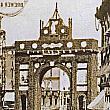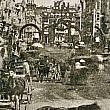Detailed Description of the Centennial Arch

The principal feature of the decorations was the Centennial Arch on Campau Place, without doubt one of the finest ever erected on the continent, and unrivaled by any other city on this centennial day. It consumed about five mile in length of heavy cedar wreaths, on the lower side intermixed with strips of red, white and blue, to cover that portion of its surface not devoted to paintings and mottoes. The following description is condensed from The Daily Eagle of July 5th: It is 66 feet wide and 12 feet in thickness, rising thus to a height of 56 feet, a heavy cornice projecting at the height of ten feet above the spring of the arch. Surmounting this structure, and in its center, is a pedestal 22 by 5 and 4 feet in height. On this is erected a rectangular tower 12 feet in height, 9 by 6, flanked on each side by medallion frames half its height, from the four corners of which heavy wreaths rise to a central staff, forming a pointed turret, the summit of which is 84 feet above the pavement. On the north side, or facing up Canal street, at the top is the coat-of-arms of Michigan, painted on a canvas 8 by 12 feet in size—a fine piece or work. On either side of it are “Lexington” and “Yorktown.” Below the coat-of-arms is “Hallelujah for Our Hundred Years.” On the base of the upper structure are “The Union and the Constitution,” “Supreme Law,” “Unfettered Conscience,” “Long Live the Republic.” Just below are “Jefferson” “Franklin.” Next are “1776” and “1876,” with the names “Marion,” “Sumter,” “Wayne,” and “Lee.” On the keystone of the arch is “The People of Grand Rapids to their Country.” On the left side of this face of the arch, in the panel over the side arch, is “The Declaration of American Independence the Baptismal Vow of a Republic born of Eternal Right, and for whom Heroes were Sponsors.” Under this is an oil painting, 8 by 12 feet in size, of Washington crossing the Delaware; a beautiful and artistic scene. Beneath is “Their Glorious Record is the Imperishable Heritage of the Forever.” In the west panel of this face of the arch, at the top, is “On Every Sea and Every Land Known to Men the Sacred Honor of the Sires has been upheld by the Sons.” Below this is a painting, 8 by 12 feet in size, representing Columbia standing in the foreground, on a high ledge, pointing over a vast and shadowy expanse, allegorically presenting the greatness and achievements of our country. In the background of the scene is the main building of the Exposition. Nearer is the National Capitol and other public structures. Still nearer is the farmer reaping grain in a broad field with a reaper. Still nearer is a river with a steamboat, a suspension railroad bridge, a second railway track and a train of cars, and a telegraph line. All can understand what they represent. Beneath this beautiful oil painting is: “Of all Nations, and Peoples, and Tongues, she Gathers the Freemen who Bless her Centennial Birthday.”
Suspended under the center of the arch is a fine painting of Washington on horse-back, ten by fourteen feet in size, under which the procession passed with uncovered heads. In the fact of the structure fronting up Monroe street are the following: At the extreme top is a painting of Rogers’ statue of Michigan, and the inscriptions, “God and My Right” and “Michigan.” Immediately under is the motto, on the upper base, “All Hail Columbia.” This is flanked at either side with “Science and Religion,” “The Mechanic Arts,” “Agriculture and Commerce” and “The Forest and the mine.” Just below are the names “Washing,” “Lincoln.” Beneath them, over the center of the arch is “In God We Trust,” which has become a National motto, since it appears on the currency of the country. Below, flanking the keystone, is “1776,” and “1876,” and the names “Lafayette,” “’Steuben,” “Putnam,” “Stark.” The keystone bears the motto “The Fidelity of the Sons in the Keystone.” In the left or western panel is an oil painting representing Washington at Valley Forge, uniform in size with those above mentioned. Beneath this is “Their Heroic Devotion Inflamed the World and made Liberty the Watchword of Mankind.” In the other panel is an allegorical painting in water colors, explained by the motto underneath “America supported by Justice and Strength receives Tribute, Affection and Confidence from he Children and Drives Discord and Fraud from her Domain.”
The grand arch was kept lighted up for several hours by red lights burned by Messrs. Mills & Lacey in front of their drug store on Canal street. Its huge proportions looked indescribably weird in the lurid light, which revealed the mottoes and paintings with almost preternatural distinctness.
The arch, together with all the painting and mottoes was designed by Col. Joseph Penney. Its erection was the work of Mr. C.H. Gifford, architect and builder.
The four panel paintings on the grand arch were executed by Sol[omon]. E. White, scenic artist, of this city, who patriotically donated half their value. The mottoes and sentiments on one side were painted by Mr. B[yron]. Morrison, and on the other by H[enry]. M. Goebel, more than two-thirds of their value being donated by each.
The equestrian painting of Washington, suspended in the arch, was executed by T. Ed. Wardus, of New York City, at that time engaged in frescoing St. James’ Church in Grand Rapids, and presented to the city. Thousands who admired its beauty and noted its finished appearance will learn with surprise the fact that it was begun and finished inside of twenty-four hours.
Excerpted from Centennial Anniversary of American Independence, Celebration at Grand Rapids, Mich., July 4, 1876: Loomis & Dillenback, Printers and Publishers, 1876.

 facebook
facebook



